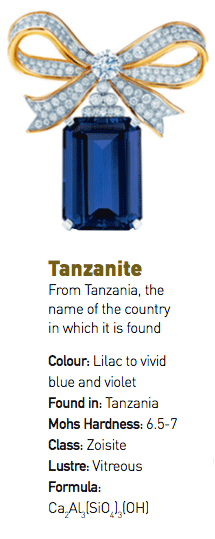 The use of tanzanite in jewellery is relatively new – it was discovered by Masai tribesmen at the base of Tanzania’s Mount Kilimanjaro in 1967.
The use of tanzanite in jewellery is relatively new – it was discovered by Masai tribesmen at the base of Tanzania’s Mount Kilimanjaro in 1967.
According to legend, a large bush fire swept the foot of the mountain, transforming the dull, greyish-brown material into glittering blue and violet crystals, which not only caught the eyes of the tribesmen but also the imagination of the world’s most- prestigious jewellery houses.
This bush fire myth perfectly illustrates the chameleon-like change that occurs when tanzanite crystals are heated to approximately 400°C – the undesirable yellow and brown tints disappear and the purple and blue tints deepen, resulting in transparent, vividly-coloured material.
Tanzanite’s unique formation has a million-to-one chance of occurring outside the areas where it is known to be found, making it significantly rarer than diamond and asserting its reputation as a truly exotic gemstone.
A sequence of complex geological events is necessary in tanzanite’s formation, including mountain-forming, metamorphism, tectonic activity and the introduction of the colouring element vanadium for those magnificent blue and purple hues.
Originally, tanzanite was confused with Kashmir sapphire and even amethyst, due to its exquisite mix of velvety blue and purple hues.
However, careful observation revealed different colours seen from different directions as the stone was rotated; it can appear blue from one direction, purple from another and a green/yellow from another – a property called trichroism.
This means tanzanite may be cut down the short axis to accentuate blue or down the long axis to accentuate purple.
There is a close association between tanzanite’s size and colour; smaller gemstones are less saturated and tend to show pastel shades ranging from light blue to pretty lilac.
Meanwhile, tanzanite in its finest quality is large and exhibits intense purple-to- blue tones.
Intense blue tanzanite in large sizes is rare and more expensive than purple because the rough does not provide as high a yield.
The story of tanzanite’s rise to fame began when it attracted the attention of Henry Platt, then vice-president of US jeweller Tiffany & Co., who immediately recognised the commercial potential of this stunning gemstone.
Platt named it in honour of its homeland, Tanzania, and introduced it to the international market in 1968.
Tanzanite is a gem variety of the mineral zoisite, a calcium aluminium silicate. Zoisite may be green, pink, grey, colourless or brown in its untreated form.
Untreated blue-to-violet tanzanite crystals are rare, and most examples are heat-treated to attain these colours.
However, beneath tanzanite’s strong exterior lies a more vulnerable side.
With a hardness of 6.5-7 on Mohs scale, it is softer than topaz (8 on Mohs scale) and requires additional care if worn in a ring due to its relatively soft and brittle nature.
Tanzanite can be worn daily in pendants and earrings but is sensitive to extremes in temperature and should not be exposed to ultrasonic cleaning or standard jewellery processes.